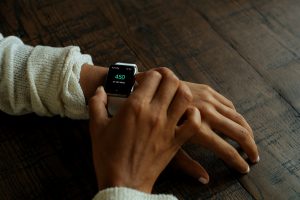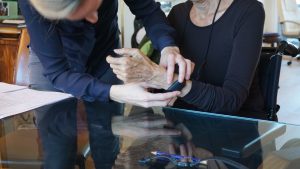
It was Christmas time three years ago when Amy experienced a stroke. Amy was enjoying her retirement, having spent her career working in publishing. But the stroke took away her independence, paralysing her left arm such that she needed full-time care. This isn’t an uncommon outcome: some 80% of people experience difficulty using their arms after a stroke.
Amy spent the next four months in hospital, the beginning of a long road to recovery.
“The rehabilitation I received in hospital mainly focused on walking, but it was my hand that I really needed help with,” she says.
“And I wasn’t told that if I didn’t use my hand that I would lose function of it.”
When Amy returned home she needed full-time care and regular rehabilitation sessions. But with an overstretched health system burdened by an ageing population, Amy wasn’t able to access the recovery support she required at home.
“I was glad to get out of hospital, but I couldn’t get the help I needed and felt very hard done by,” she says. “I had to take charge of my own recovery.”
Spotting gaps in stroke services
Amy joined a local network called LEGS (Local Exercise Groups for Stroke), a charity that offers physiotherapy-led rehabilitation for stroke survivors. It was here that she met Ella Gibbs and Gianpaolo Fusari from our Helix Centre, who were working on a solution to help people like Amy.
“Stroke is the leading cause of disability in the UK, so we were really motivated to work in this area and find out where we could use design to make a difference to people’s lives,” says Gianpaolo, senior designer at Helix, an innovation lab for healthcare.
“We wanted to learn more about what happens both in the hospital and in the community, so we shadowed teams of therapists on wards, linked up with various charities and also observed rehabilitation sessions in the home environment.”
It was the latter scenario where Gianpaolo realised there was a major gap to be filled.
“We followed early-support discharge teams, the therapists who go to people’s homes five days a week for 45 minutes to do intensive therapy,” he says.
“It’s a really great service, but only about 20-30% of eligible people receive it because there aren’t enough therapists to go around.”
A numbers game
The team ran workshops with patients and healthcare professionals to further flesh out people’s needs after stroke and better understand their feelings. It became clear that the lack of help at home was a real roadblock in people’s recovery.
“People felt unsupported after their formal rehabilitation programmes ended,” says Ella, physiotherapist and clinical researcher. “They were afraid to do some exercises at home for fear of injuring themselves. And they didn’t have any way of monitoring their own progress. The same goes for the therapists, who couldn’t see whether their patients were sticking to their exercises between sessions.”
Evidence suggests that stroke survivors need to perform hundreds of exercise repetitions every day to recover the function of their affected limbs. But even for those fortunate to be eligible for support at home, typical therapy sessions simply aren’t long enough to achieve those kinds of numbers. So rather than looking for an unlikely solution in these narrow windows, the Helix team began to focus on life outside of therapy. They wanted to help people help themselves – empowering them to take charge of their own recovery.
“There’s increasing emphasis on this self-management aspect of treatment for people with longer-term conditions,” says Jennifer Crow, an occupational therapist at Charing Cross Hospital who has been working with Helix on the project.
“Because people aren’t going to get a therapist’s help every time they need to do something. There simply aren’t enough of us. I believe self-management has to be the way of the future.”
A recipe for rehabilitation
Working with some 200 patients and healthcare professionals like Amy and Jennifer, the Helix team created a digital tool – OnTrack Rehab – that enables self-management of stroke recovery.
This platform couples a smartwatch app with tailored coaching to help people own their rehabilitation journey at home. The app works like a step counter. It tracks minutes of arm activity through an algorithm developed specifically for stroke survivors, whose arm movement differs from healthy individuals’.
“That’s the ‘secret sauce’ of our innovation,” says Gianpaolo.
The device displays these minutes to the user, alongside a daily goal and what they achieved the previous day. The app also sends the user tailored messages – depending on how active they are – to motivate and encourage them.
“It’s great – it reminds you to use your hand,” Amy says. “I think you need constant reminding that it’s there and needs to be used. I think it’s helped me to be more aware of that.”
Earlier versions of OnTrack showed users much more information. But testing sessions showed that people found it overwhelming and difficult to make sense of.
“What really struck me was how the Helix team really listened. Not just to us, the therapists, but to the patients as well,” Jennifer says. “Throughout this project they’ve always taken on board our suggestions, so that the next time we see them, they’ve made appropriate iterations. So much other research is done without any prior consideration of patients’ actual needs, which is so important.”
No single silver bullet
OnTrack shares the activity data it gathers not only with the users themselves, but also with their therapists. This offers a window into what happens between therapy sessions. The OnTrack team also uses this information to provide regular, tailored coaching sessions, which the therapists consult on.
By motivating people to better engage with their rehabilitation at home, OnTrack hopes to complement therapists. And ultimately, reduce the need for therapy sessions, which are in scarce supply.
Results from a pilot study in 2018 with 10 people showed an average increase in activity of 20%, which equates to roughly an extra hour of arm activity per day. While promising, the team can’t be sure that this improvement was due specifically to OnTrack. That’s why they’re now carrying out a more robust feasibility study with a larger number of patients and an independent evaluation.
The road ahead
Despite the years of research and development so far, it’s still early days for OnTrack. The team has more to do to refine the product and its features. They also need to demonstrate its impact on rehabilitation outcomes at scale. But if trials support its use, Gianpaolo has high hopes for the platform.
“In the short term, we want to see how it can integrate with NHS practice, becoming part of the services offered to stroke survivors here and hopefully in other countries in the future,” he says. “We also want to explore whether we can adapt OnTrack for rehabilitation in other areas. For example people living with Parkinson’s disease.”
The OnTrack team is excited for the road ahead and to helping many more people like Amy recover from stroke.
This work has received funding from the NIHR Imperial Biomedical Research Centre. Read about other Helix work here.